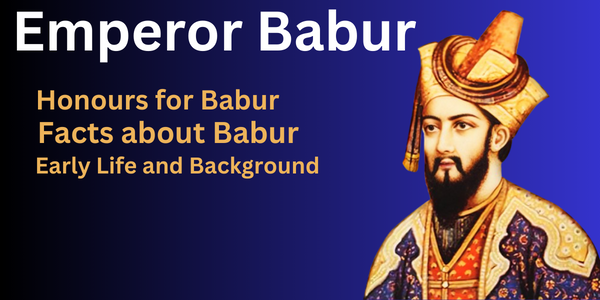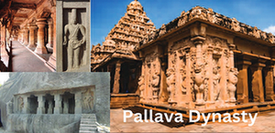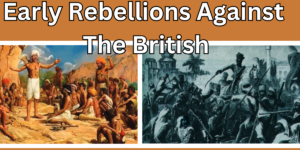Emperor Babur
Honours for Babur:
Soviet and Uzbek sources consider him an ethnic Uzbek.Babar is considered a national hero in Uzbekistan and postage stamps were issued in his name in 2008 to commemorate his 525th .Many of his poems became popular Uzbek folk songs, and he was recognized as a hero in Kyrgyzstan.Pakistan developed the Babur Cruise missile in his memory in October.Babar’s life has been depicted in Indian films such as “Shahenshah Babar” (1944) and “Baabar” (1960), which contributed to his cultural legacy.Babur left behind an autobiography called “Baburnama”.
Facts about Babur:
- Full name: Zahir-ud-din is also known as Muhammad
- Born: February 14, 1483 in Andijan, Timurid Empire
- Parents: Umar Sheikh Mirza and Qutlaq Nigar Khan
- Children: Humayun, Gulbadan Begum, Kamran Mirza
- Died: December 26, 1530, in Agra, Mughal Empire
Name:Emperor Babur
Babur’s official name was Ahir-ud-din Muhammad, given to him by the Sufi saint Khwaja Ahrar.The name has a deeper meaning:
- Ẓahīr-ud-Dīn translates as “defender of faith” (referring to Islam)
- Muhammad honors the prophet of Islam.
Babur’ s nickname was “Babur“, and this nickname may have come from the Persian word for “tiger” or “panther”, referring to Babur’s strength and courage.
Emperor Babur – Early Life and Background:
He was born on 14 February 1483 in Andijan in the Ferghana Valley (present-day Uzbekistan).
He was the eldest son of Umar Sheikh Mirza, the ruler of the Ferghana Valley.Descendant of ‘Genghis Khan’ grandson of Abu Sayd Mirza, a descendant of Timur and daughter of Yunus Khan, the ruler of MoghulistanHe belongs to the Barlas tribe, of Mongol origin, who embrace Turkish and Persian culture.Sagatai is fluent in both Turkish (his mother tongue) and Persian, the language of the Timurid elite.Babur’s relatives and uncles Mahmud Khan (Mogul Khan) and Ahmad Khan were identified as Mongols and supported him with the Mongol forces.Despite his nominal Mongol identity, Babur received significant support from the local Turkic and Iranian populations in Central Asia.His army showed diversity, including the Charts, Tajiks, Afghans, Arabs, Barlas, and Chadayit Turko-Mongols .Babur’s memoirs, known as the Baburnama, provide important details about his life.Chagatai was originally written in Turkish and later translated into Persian during the reign of his grandson Akbar.
Early Babur :
In 1494, the eleven-year-old Babur became the ruler of Ferghana (present-day Uzbekistan).His younger brother Jahangir supported the throne against the challenges of uncles and nobles.Aisan Daulat Begum was instrumental in securing his successor.Constant threats from hostile uncles and rival princes in neighboring regions.Samarkand was successfully conquered in 1497 at the age of 15.Lost Samarkand to a rival prince and faced a rebellion at home, losing.For three years he focused on building a strong army.An attempt to recover Samarkand in 1500-1501, but faced a siege by Muhammad Shaibani, led to Babur’s exile.Wandered the mountains of Central Asia, facing short-lived conquests and exile, with the help of friends and peasants.
He captured Kabul from Argunidz in 1504 and established a new kingdom.His first voyage to India in 1505 marked his constant desire for Hindustan.He worked with Sultan Hussain Mirza Bekara against the common enemy Uzbek Shaibani.Sultan Husain Mirza stayed in Herat after the death of Pykara, enjoying cultural richness but facing resource challenges.He retained power despite a rebellion among the generals.He formed an alliance with Shah Ismail in an attempt to reconquer Central Asian territories.They formed an alliance with Shah Ismail and managed to recapture Samarkand in It began to modernize the army in times of rebellions, attacks and relatively
Formation of the Mughal Empire:
Faced with the challenges of the Uzbeks, Babur reached the Chenab river in 1519 and chose India as his refuge.Babur was called by Daulat Khan Lodi and Ala-ud-din and claimed to be the rightful successor to the Delhi Sultanate.Marching to Lahore, Daulat Khan surrendered, and in three weeks Babur became master of the Punjab.Babur faced Ibrahim Lodi’s army at Panipat, and Tulukma used tactics to lead to victory and the end of the Lodi dynasty.
After Ibrahim Lodi’s death, Babur occupied Delhi and Agra and usurped Lodi’s throne.He laid the foundation for Mughal rule in India, but faced challenges from rivals, including Rana Sanga.Expressing his victory over Ibrahim Lodi’s superior army, Babur attributed his victory to the grace of God Almighty.Babur’s conquests in northern India marked the establishment of the Mughal Empire, paving the way for future rulers.
Battle of Panipat 21 April 1526:Emperor Babur
The Afghan Lodi dynasty ruled the Delhi Sultanate from 1451, and Ibrahim Lodi had been king since 1517.Babur, a descendant of Timur and Genghis Khan, ruled Ferghana (Uzbekistan) and conquered Kabul in 1504.Invited by Daulat Khan, the governor of Punjab, Babur tried to challenge Ibrahim Lodi’ s rule after suffering a setback in capturing Samarkand.In 1524, Babur reached Lahore but was repulsed by Lodi’s forces.Despite failed attempts with the support of the rebels, Babur prepared better in 1526 and efficiently organized his small army.Babur surprised the army dependent on Lodi’s cavalry by introducing gunpowder rifles and field artillery.Babur’s strategic acumen played an important role, including the Tulkuma (military wing) and the Araba (cannon firing carriages).Lodi’s 50,000-strong army was defeated by just 12,000 troops.The death of Ibrahim Lodi put an end to the Lodi dynasty and the Delhi.This war paved the way for Mughal rule in India and established Babur’s dynasty.
Battle of Canwa (c. 1527 CE):Emperor Babur
The Battle of Khanwa was fought on 16 March 1527 between Babur and Rana Sanga, the Rajput ruler of Mewar.Rana Sanga aimed to overthrow Babur, whom he saw as a foreigner ruling in India, and tried to expand the Rajput territories by capturing Delhi and Agra.The Afghan chiefs supported Rana Sanga because of Babur’s unfulfilled promises.Aware of Rana Sanga’s advance towards Agra, Babur took a defensive position at Khanwa in present-day Rajasthan.Babur’s victory is attributed to his “superior communism” and his use of modern techniques, including cannons and musk.The treachery of the Hindu chief Silhadi, who joined Babur’s army with 6,000 men, played an important role in the defeat of Rana Sanga.
Battle of Chanderi (1528 km.B):
The Battle of Khanwa was followed by the Battle of Chanderi, and Babur learned of Rana Sanga’s preparations for renewed confrontation.Babur aimed to isolate Rana Sanga by defeating one of his important allies, Medini Rai, the ruler of Malwa.On 20 January 1528, Babur offered Shamshabad to Medini Rao as a peace token in exchange for Chanderi, but the offer was rejected.Babur’s army captured the outer fort of Chanderi at night.It was followed by the capture of the Upper Fort the next morning.Medini Roy, having no hope of victory, arranged a jauhar where the women and children in the fort self-immolated themselves.A small group of soldiers committed collective suicide at Medini Rao’s house. However, Babur did not appreciate this sacrifice in his autobiography.
Battle of Ghaghra (1529 CE):
After conquering the Rajputs, Mughal emperor Babur moved eastwards and defeated the Afghans at the Battle of Ghagra in 1529.This conquest extended Babur’s control over northern India, including parts of Punjab, Agra, Awadh, Gwalior, Bihar and parts of Rajasthan.Babur established Delhi as the capital of the Mughal Empire.However, Babur did not live long to enjoy the fruits of his conquests. B died in 1530, four years after the battle ofApart from being the founder of the Mughal Empire, Babur was also a talented poet and writer. His biography, Baburnama (in Persian) and Tusk-i-Baburi (in Turkish), provide insights into his life and period.He developed various gardens, the most famous being the Rambagh Garden in
Death of Emperor Babur:
Babur was not given enough time to see the fruits of his victories. g. In 1530, four years after the battle of Panipat, Babur On December 26, 1530, Babur died in Agra at the age of He was succeeded by his eldest son Humayun.His lifeless remains were initially buried in Agra, but, following his wish, they were later taken to Kabul and reburied at Bagh-e Babur between 1539 and Babur was a prolific poet and writer and is famous as the man who founded the Mughal Empire.
Learn about : The Administration of the Mughal Empire
Learn about : Mughal Rulers




In my opinion it is obvious. I advise to you to try to look in google.com